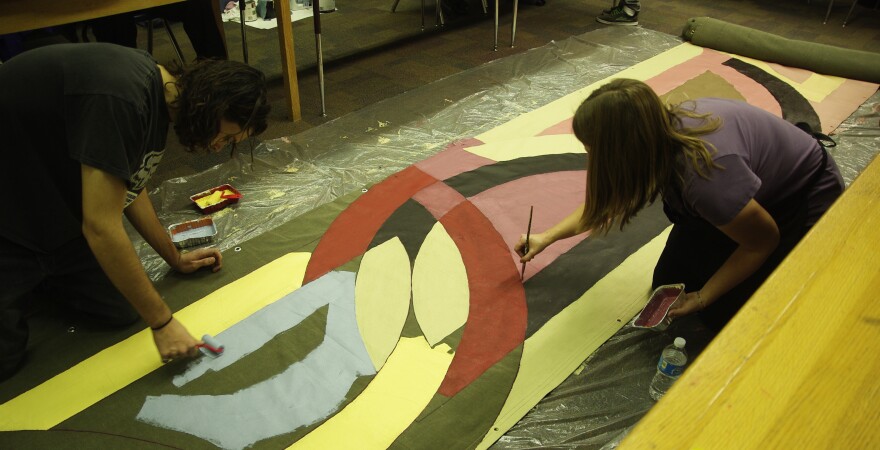Discussions about the need for and relevance of art education in the classroom have been ongoing over recent years as school districts continue to do battle with depleting budgets. Today we visit a high school art teacher and her students to learn just how important they feel art is – and ask their opinion on plans to broaden art education through Rapid City’s Main Street Square sculpture project.
It’s been quite a while since I sat in an art class. In fact, the last time I received any education about art was while watching Bob Ross on “The Joy of Painting”.
Well, things have changed quite a bit since I was in school. Art class at Rapid City Academy’s Lincoln Campus, for example, is a lot different than it was at Bishop Ford High School when I was a freshman. And it’s nothing like Bob Ross.
“We come into art class every day and we have a different object in the center of the room,” says Gabrielle Seeley. “And students draw that object for the duration of one song. And the song is different every day, too.”
Gabrielle Seeley is the art teacher at Lincoln High School. “Mrs.” Seeley says her routine of incorporating music into the first few minutes of class places her students in a creative mindset as well as giving them the opportunity to practice drawing daily.
“Which is essential for either 2-D or 3-D artists,” she comments. “It’s kind of a ritual that we rely on as artists in the studio.”
It’s this deeper insight into the process of creating art that has brought me to Mrs. Seeley’s art class – which she calls her art studio, and where each of her students is a fellow artist.
“The classroom is a working studio,” Seeley explains. “And all studios are run by some lead artist. And I’m the lead artist in the studio and they are the other artists in the studio. So, we run the studio like a professional studio, where we have organizational rules, we have structures that are in place to create a lot of high level thinking.”
Yes, it is quite a bit more involved than paint-by-numbers or arts and crafts. And the organizational rules and structures begin with Mrs. Seeley’s daily art with music exercise.
“And they have noticed that this increases their skills exponentially and really painlessly,” says Seeley. “Skills in a lot of areas, I think. I’m teaching business skills through art. I’m teaching people how to interact with each other through art. I’m teaching people how to manage their emotions and anger through positive outlets…which means through art.”
Mrs. Seeley adds that, contrary to what many believe, teaching children art will benefit them in all aspects of their lives – even in the business world.
“I’ll tell you what…creative thinking is a very saleable commodity,” Seeley insists. “Okay? And when you can get employees thinking more creatively, that equates to innovation. Innovation can lead to efficiencies and strengths in thinking across fields. And I know in my own experience, the times that I needed to solve a problem in my work life…when I could make myself think creatively, I could solve the problem. And I see students do it every day.”
That “work life” Mrs. Seeley refers to is the 13 years she spent in corporate management before becoming an art teacher. And it’s that knowledge of how art can benefit people in all areas of life that has Mrs. Seeley excited about a new art program scheduled to be part of the Main Street Square Sculpture Project.
I’m sitting across town at Main Street Square with Anna Huntington. She’s the Community Art Coordinator for the sculpture project. Anna explains just what Yuki Nagase – the project’s sculptor - plans to do with part of his artist’s commission.
“We’re going to train professional artists to teach visual art fundamentals in public schools in the Rapid City area,” says Huntington. “We’re targeting third through fifth grade.”
Sessions in the Teaching Artists Program are 30 minutes long, once a week for six weeks. Like Mrs. Seeley, Anna Huntington is excited about bringing the program to young students in schools that currently have no formal art instruction for grades K through 5.
Back at Lincoln High, I ask a few of Mrs. Seeley’s students what they think of the Teaching Artists Program.
“It’s a great opportunity for the little guys,” says Nathan Raab. “They deserve just as much time in art as we do.”
Mathew Pagan agrees and adds, “I think it just shows that he cares about students.”
“I think it’ll make them, like, feel better because I know it made me feel a lot better when I got to do a lot more art,” recalls Mena Brink.
“A number one fact is singers and people who play instruments and people who do art are better learners,” explains Rachel Francis, “because they use more of their brain to concentrate. And the fact that he’s doing that for children to get them to concentrate more…that is amazing.”
Gabrielle Seeley hopes the understanding her students have of art’s benefits will expand into the business world and beyond; so that one day art will be a standard part of classroom education.
Meanwhile, there’s the Teaching Artists Program.
http://www.rcsculptureproject.com/
https://www.facebook.com/TheSculptureProjectPassageOfWindAndWater
https://twitter.com/rcsculpture


